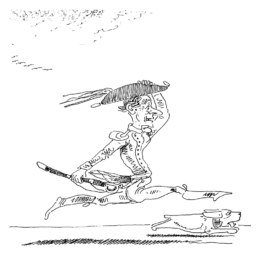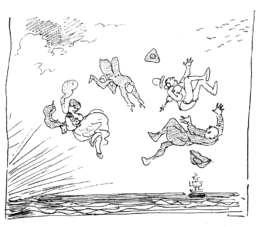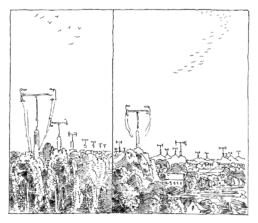in collaboration with
Institut Français Italia, Università di Bologna – Scuola di Lettere e Beni Culturali, Pro Helvetia, Accademia di Belle Arti di Bologna
promoted by
Transbook Children’s Literature on the Move



Rodolphe Töpffer is today known as the “father” or “creator” of the comic strip itself. As deeply embedded in 19 th century’s Europe, the genevan writer and artist managed to embrace all the various forces which gave birthto the comic strip in the end of the century: the enhancement of
printing technologies contemporary to the expansion of the public, the evolution of caricature art and the increasing spread of the printed copies, the mutation of the narrative structures. Critics (mostly Thierry Groensteen) wasn’t the only one to recognize Töpffer as the pioneer of Comics, many authors since the ‘90s, (from Art Spiegelman to David B, from Chris Ware to Anke Feuchtenberger) have acknowledged him the real parenthood of the art.
conference
The amazing adventures of Mr. TopfferFriday, November 24th h 9 am -1.30 pm | Accademia di Belle Arti di Bologna - Aula Magna
with Aldredo Castelli, Antonio Faeti, Fabio Gadducci, Thierry Groensteen, Philippe Kaenel
introduced by Enrico Fornaroli
moderated by Emilio Varrà
Rodolphe Töpffer’s masterpiece and thought describe the times where they come from, where huge transformation took place in Western Society, representing a meaningful leap forward. In order to understand the intuitions of the Swiss artist, still surprising nowadays, BilBOlbul invited great experts from different countries to confront each other. In the exhibition we will see people like art historian Philippe Kaenel (Switzerland), semiologist and theorist of comics Thierry Groensteen (Belgium), writer and essayst Antonio Faeti, screenwriter and “archeologist” of early comics Alfredo Castelli, and expert of 19 th century comics Fabio Garducci.
Thierry Groensteen
Clarifications about “Momento Töpffer”
Töpffer made a crucial break in the long history of pictured storytelling. Comics still owes him so much for its beginning. Although, expressing itself as a modern medium, it may ignored its old
advices.
Antonio Faeti
Vero è ben, Pindemonte! Irony, melancholy, wisdom and narration, combined together make Rodolphe Töpffer.
Philippe Kaenel
Zigzag exploring genres: journey tales, theatre and “les histoires en estampes”.
In the end of the ‘20s, Rodolphe Töpffer increases his working. He teaches, arranges trip with his pupils, makes art critics writings, tales and essays; he also creates plays for private show where the artist himself is an actor, he draws pictures all the time about figures and landscapes. This is the birth of “les histoires en estampes”, outcome of the joint of all his miscellaneous activities.
Fabio Gadducci
“Pictured storytelling” in Italy before and after Töpffer.
Rodolphe Töpffer’s role in evolution of comics and influence on the French market have been studied very carefully. Not finished yet are the investigations on the flow of comics imagery in the whole European culture. The purpose of the research consists in offering a primal acknowledgement about the “pictured storytelling” in Italy in the early 19 th century, before and after Töpffer, in an effort to define the genevan artist’s influence in our country.
Alfredo Castelli
Martin Mystère, the detective of the impossible, meets Rodolphe Töpffer in Florence, as he’s working on “Viaggio a Zig Zag”.
This short meta-comic book, illustrated by Lucio Filippucci, shows these same stylish innovation used for the first time in Töpffer’s rôleries, in the second decade of the 19 th century, then forgotten and discovered again.
exhibition
Mr. Töpffer's new inventionsAl Cappello Rosso
with Nicolas Robel, Francesco Cattani, Ratigher
Designer, novelist, art critic and pedagogist, Genevan Rodolphe Töpffer is often referred to as the “comic book inventor”. In fact, his work represents the essential link from which modern sequential art developed, while his aesthetic and narrative achievements anticipate the graphic novel. Along with exceptional theoretical awareness and unique productive techniques, nowadays what is still surprising is the effectiveness of his histoires en estampes, tales in which adventure, humor and a critical take on reality mix perfectly.
Within the project dedicated to Rodolphe Töpffer, which also includes a conference of and an experimentation with the autograph printing process (revealed in a video in which the lithographer Steve Mancini experiments with the technique), BilBOlbul asked the Swiss Nicolas Robel and to the unusual couple formed by Italians Francesco Cattani (drawings) and Ratigher (texts) to tell new adventures by reinterpreting the characters and by confronting the style of the Geneva artist. Where Robel makes variations on Topfferian cadences to recount the passage from childhood to adolescence, Cattani and Ratigher play with the theme of escape from bourgeois everyday by borrowing one of Töpffer’s anti-heroes.
Nicolas Robel, born in Quebec but raised in Geneva, is an illustrator, publisher and graphic designer. In 1999 he founded B.ü.L.b comics, “sequential art publishing house”, and graphic studio B.ü.L.b grafix. He has participated in the collectives “Drozophile” and “Strapazin” and has published numerous graphic novels and illustrations.
Francesco Cattani, (Bologna, 1980) was among the founders of independent label ernest. He has published comic book drawings and stories for many magazines and two graphic novels: Barcazza (2010) and Luna del mattino (2017).
Ratigher (1978) created the comic book and music label Donna Bavosa in the late nineties, is among the five founders of the Super Amici group and invented the Primaomai production and sales method. He is one of Dylan Dog‘s screenwriters and, since 2017, the Editorial Director of Coconino Press-Fandango.
meeting
Drawing TöpfferSaturday, November 25th h 3.30 pm | Libreria Ubik Irnerio
with Francesco Cattani, Nicolas Robel. Modera Alessio Trabacchini
in collaboration with Pro Helvetia
Authors Nicholas Robel and Francesco Cattani have been called to talk about Töppfer’s comics. His figures inspired both of them to create two stories in four pages which will be presented during the meeting and published on BBB17 in corso d’opera (for sale during the festival).
biography
Rodolphe Töpffer (Geneva, 1799-1846) was a Swiss Illustrator and caricaturist. He can be
considered the “first cartoonist in history”, his work, indeed, is way closer to the modern idea of
comic strip than his predecessors’. His father was a well known painter of his era and, as people
were used to, Rodolph had to follow his footsteps. However, because of a disease which affected his eyes, had to move to take cures in Paris, where continued his studies and experienced the local art. In the meantime he wrote some short works as La Bibliothèque de Mon Oncle (1832), Nouvelle
Genevoises (1841), Voyages en zig-zag (1843).
Since his eye disease didn’t seem to heal, he had to give up on his painting vocation and focusing on teaching, turning into a professor of literature in the University of Geneva. Since 1827, Töpffer started drawing short stories for his pupils which, on advise of his friends, decided to publish,
starting off with the of Histoire de Monsieur Jabot in 1833. In the following years seven more
stories were completed: Monsieur Crépin (1837), Les Amours de M. Vieuxbois (created in 1827 and published in 1837), Monsieur Pencil (created in 1831 and published in 1840), Le Docteur Festus (created in 1831 and published in 1846), Historie d’Albert (1845) and Histoire de Monsieur
Cryptogame (1845). In 1842 one of these stories already has been translated in English for the
United States. His stories are humorous and have fictional characters. His main characters (Monsieur Jabot, Crépin, Vieuxbois, Pencil, Dr. Festus, Monsieur Crytogame ) reached quickly a
great success, so much that they kept being published in magazines for masses for a long time,
revealing their economical potential.

